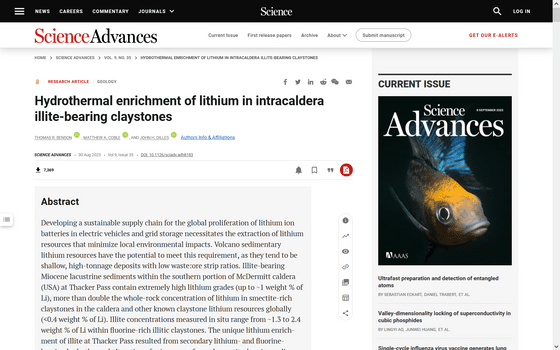Possibility that 40 million tons of lithium, the largest in history, is buried in a lithium deposit discovered in the United States

Known exploration has uncovered numerous deposits of metals containing lithium from volcanoes across Nevada and Oregon. According to a paper published on August 30, 2023, this volcano seems to have the world's largest lithium deposit, estimated at 20 million to 40 million tons.
Hydrothermal enrichment of lithium in intracaldera illite-bearing claystones | Science Advances

Lithium discovery in US volcano could be biggest deposit ever found | Research | Chemistry World
The key ingredient to millions of EVs is buried under a former volcano — but there's still a lot we don't know - The Verge
https://www.theverge.com/2023/8/30/23849619/lithium-ev-battery-thacker-pass-mine-mcdermitt-caldera
McDermitt Caldera , a volcano on the border between Nevada and Oregon, has not been confirmed to be active since a series of eruptions that began about 16.3 million years ago.
In 2017, a research team discovered evidence that a section of the caldera called Tucker Pass may be one of the largest lithium deposits ever discovered. When researchers from Lithium Americas, an American lithium developer, and Oregon State University conducted a survey, they found that a rare claystone made of the mineral 'illite' discovered nearby was more than twice as strong as existing claystones. The possibility that it has a lithium concentration has emerged. The findings were reported on August 30, 2023.

by
Researchers said claystones found elsewhere contain at most less than 0.4% lithium per 100g, but those found at Tucker Pass contained between 1.3% and 2.4% lithium per 100g. It is estimated that an estimated 20 million to 40 million tons of lithium may be hidden near Tucker Pass.
Thomas Benson, a geologist at Lithium Americas who led the study, said, ``Previous studies suggested that lithium was leached from volcanic glass and accumulated in the caldera, but that alone was not sufficient to show that the lithium was surprisingly high. We couldn't explain how the high concentrations of lithium accumulated. Our hypothesis is that a phenomenon called hydrothermal enrichment occurred, and magma moving beneath the surface carried the lithium close to the surface. It is thought that.''

This research will help Lithium Americas, which has the mining rights to the McDermitt Caldera, consider where to mine. 'Hydrothermal enrichment is not occurring in the northern part of the volcano. I think we need to focus on the southern region where illite is present,' Benson said.
Lithium Americas plans to begin mining lithium deposits in 2026, but has faced strong

Related Posts:
in Posted by log1p_kr







